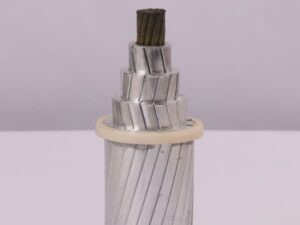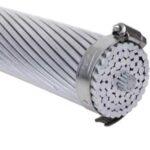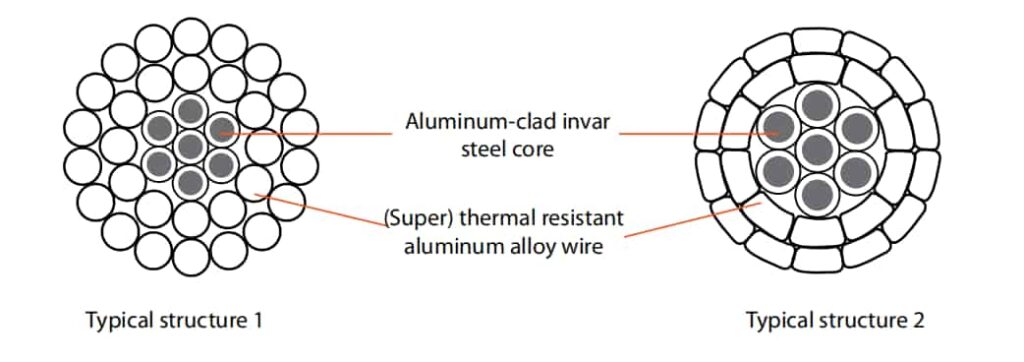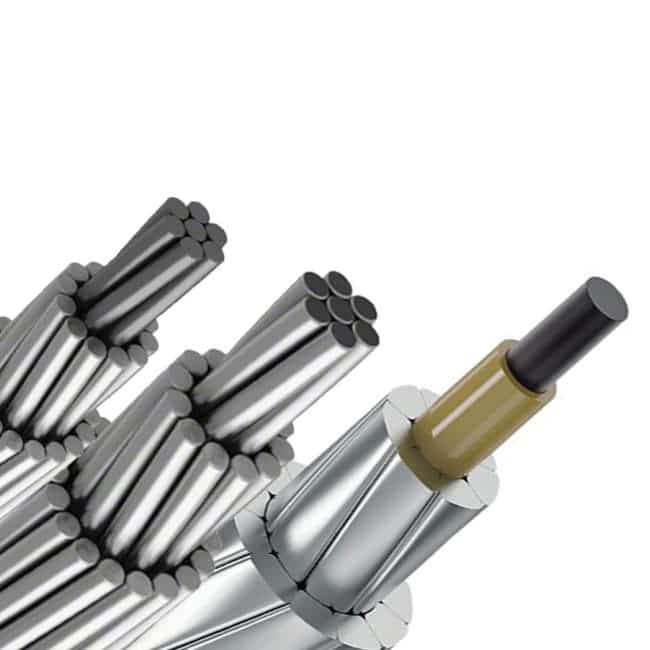HTLS 지휘자
고온 저처짐 도체 (HTLS 도체 케이블) 최대 250°C의 온도에서 작동하도록 설계되었습니다., 기존 도체보다 더 큰 전기 부하를 전달할 수 있습니다..
HTLS 도체는 기존 가공선이 여유 문제에 직면하고 전류 운반 용량이 제한되는 상황에서 특히 유용합니다., 따라서 더 높거나 더 새로운 타워의 설치를 방지합니다..
HTLS 도체는 대부분의 기존 타워를 광범위하게 수정하지 않고도 전류용량을 증가시켜 솔루션을 제공합니다..
ACCC 도체를 포함하는 HTLS 도체, ACSS 지휘자, ACSS/TW, ACSS/AW, 인바 도체-TACIR 및 ZTACIR, GAP형 도체 – GTACSR 및 GZTACSR, 내열도체 – TACSR/AW.
HTLS 지휘자 지휘자
ACCC 지휘자

알루미늄 도체 복합 코어,ACCC 컨덕터는 탄소-유리섬유 복합재료로 구성된 경량 코어에 열처리된 1350-O 알루미늄 와이어를 사다리꼴 모양으로 묶어 만든 도체입니다..
ACCC 알루미늄 도체 복합 코어는 기존 강철 코어 도체에 비해 뛰어난 강도와 가벼운 무게를 제공합니다.. 최대 180°C의 온도에서 연속 작동하도록 설계됨, ACCC는 기존 ACSR 도체보다 두 배의 전류를 전달할 수 있습니다.. 가벼운 코어로 대략적인 사용이 가능합니다. 30% 전체 무게를 늘리지 않고 더 많은 알루미늄.
ACCC는 라인 손실을 다음과 같이 줄입니다. 30 에게 40% 동일한 직경과 무게의 기존 ACSR 도체와 비교하여 동일한 부하 조건에서. 강화된 강도, 효과적인 자체 감쇠 특성, 우수한 피로 저항, 낮은 열팽창 계수로 무거운 전기 부하 시 도체 처짐 최소화, 더 적거나 더 짧은 지지 구조 사이의 범위를 늘릴 수 있습니다.. 추가적으로, ACCC 도체는 기존 ACSR 도체에 비해 내식성이 더 뛰어납니다..
ACSS 도체 및 ACSS/TW 도체

ACSS 지휘자,알루미늄 도체 알루미늄 피복 강철 지원 (ACSS/AW) ACSS/AW의 대부분 또는 모든 기계적 부하를 견디도록 설계된 알루미늄 클래드 강철 와이어의 중앙 코어 위에 연선된 단련된 알루미늄 1350-O 와이어의 하나 이상의 레이어로 구성됩니다.. ACSS/AW 도체는 ASTM B에 따라 제조됩니다. 856, 다른 표준이 제공될 수 있음.
ACSS/AW는 최대 200°C의 고온에서도 손상 없이 지속적으로 작동할 수 있습니다.. 알루미늄 피복 강철 코어, 두꺼운 알루미늄층으로 이루어진 (대략. 10% 공칭 와이어 반경) 강철 위에, AcSS/AW 도체는 표준 ACSS의 장점과 알루미늄의 경량 및 우수한 전도성, 강철의 높은 인장 강도 및 견고성을 제공합니다..
인바 도체-TACIR 및 ZTACIR

인바 도체는 알루미늄 클래드 인바 코어와 내열성 알루미늄 합금 와이어로 구성됩니다.. 이 도체는 기존 라인 수정에 적합합니다.. 용량을 늘리면서 동일한 처짐을 유지할 수 있습니다..
Invar 전도체는 낮은 열팽창 계수로 알려진 니켈-철 합금입니다., 이는 온도 변화에 따라 팽창 및 수축이 최소화됨을 의미합니다.. 이러한 특성 덕분에 INVAR 도체는 온도 변화로 인해 도체가 크게 팽창하거나 수축할 수 있는 응용 분야에 특히 적합합니다..
Invar 도체는 다양한 온도에서 일관된 도체 길이를 유지하는 것이 중요한 상황에서 사용됩니다.. 이러한 안정성은 가공 송전선로의 처짐을 최소화하는 데 도움이 됩니다., 효율성과 안전성에 영향을 줄 수 있는. INVAR 도체의 사용은 열팽창 및 수축으로 인한 빈번한 조정 필요성을 줄여 안정적인 전력 전송을 보장하는 것을 목표로 합니다..
HTLS 도체 전류 운반 용량

HTLS 지휘자 (고온 낮은 처짐) ACSR과 같은 기존 도체에 비해 더 높은 전류를 전달하도록 설계되었습니다. (알루미늄 도체 강철 강화). HTLS 도체의 전류 전달 용량은 설계를 포함한 여러 요소에 따라 달라집니다., 작동 온도, 그리고 구체적인 적용 조건. 다음은 전류 운반 능력과 관련된 몇 가지 일반적인 특성과 이점입니다.:
더 높은 작동 온도: HTLS 도체는 최대 250°C 이상의 온도에서 작동 가능. 이러한 높은 온도 기능을 통해 기존 도체에 비해 과열 없이 더 많은 전류를 전달할 수 있습니다..
향상된 전류용량: 디자인과 소재의 특성으로 인해, HTLS 도체는 일반적으로 비슷한 크기의 기존 ACSR 도체보다 약 2배의 전류를 전달할 수 있습니다.. 이렇게 증가된 전류용량은 광범위한 수정 없이도 기존 가공선의 송전 용량을 최적화하는 데 도움이 됩니다..
효율성과 신뢰성: 더 높은 전류를 전달함으로써, HTLS 도체는 저항 손실을 줄입니다. (I²R 손실) 전송선에서. 이로 인해 전력망의 효율성과 신뢰성이 향상됩니다., 더 적은 에너지 손실로 더 많은 전력을 전송할 수 있기 때문입니다..
전송의 유연성: HTLS 도체는 더 높은 전력 수요를 처리하기 위해 기존 송전선을 업그레이드하는 유연성을 제공합니다.. 혼잡한 도시 지역이나 새로운 송전 인프라 구축이 어렵거나 비용이 많이 드는 지역에서 특히 유리할 수 있습니다..
전반적인, HTLS 도체 효율성 제고에 기여, 신뢰할 수 있음, 더 높은 전류 전달 용량과 온도 탄력성을 활용하여 전기 전송 시스템의 용량.
HTLS 도체 사양 및 HTLS 도체 유형
HTLS 도체 사양:
HTLS (고온 낮은 처짐) 도체는 일반적으로 다음과 같은 사양을 갖습니다.:
작동 온도: 높은 작동 온도를 견딜 수 있도록 설계되었습니다., 일반적으로 최대 250°C 이상, 과열 없이 더 많은 전류를 전달할 수 있습니다..
재료: HTLS 도체는 전도성 연선을 위한 고강도 알루미늄 합금 및 코어를 위한 경량 복합 재료와 같은 고급 소재를 사용하는 경우가 많습니다.. 이러한 재료는 무게를 줄이고 기계적 강도를 높이는 데 도움이 됩니다..
설계: 도체는 전기 저항을 최소화하는 특정 기하학적 구조와 구조로 설계되었습니다. (낮은 손실) 전류 운반 능력을 향상시킵니다. (높은 전류용량).
새그 성능: 높은 전기 부하 조건에서 낮은 처짐을 갖도록 설계되었습니다., 지지 구조물 사이의 간격을 연장하고 추가 타워의 필요성을 줄입니다..
부식 저항: HTLS 도체는 일반적으로 부식에 대한 저항성이 우수합니다., 다양한 환경 조건에서 수명과 신뢰성 보장.
HTLS 도체 유형:
HTLS 도체에는 여러 유형이 있습니다., 각각은 특정 애플리케이션 및 성능 요구 사항에 맞게 설계되었습니다..
HTLS 도체 크기 및 HTLS 도체 가격
HTLS 도체 크기:
HTLS (고온 낮은 처짐) 도체는 전기 전송 시스템의 다양한 전압 및 전류 전달 요구 사항을 충족하기 위해 다양한 크기와 구성으로 제공됩니다.. HTLS 도체의 크기는 일반적으로 단면적에 따라 지정됩니다., 전류 용량을 결정하는 것 (현재 운반 능력), 기계적 강도, 그리고 전반적인 성능. 일반적인 크기와 사양은 다음과 같습니다.:
단면적: HTLS 도체의 단면적은 수백 평방 밀리미터에서 수천 평방 밀리미터까지 다양합니다.. 단면적이 클수록, 도체의 전류용량이 높을수록.
전압 정격: HTLS 도체는 전송선의 특정 응용 분야 및 요구 사항에 따라 다양한 정격 전압에 맞게 설계되었습니다.. 그들은 고전압 모두에 사용될 수 있습니다 (HV) 그리고 초고압 (EHV) 전송선.
좌초 및 건설: 도체는 일반적으로 함께 꼬인 여러 개의 알루미늄 또는 알루미늄 합금 와이어로 구성됩니다., 종종 소형 또는 반소형 구성으로 사용됩니다.. 구성 및 좌초 패턴은 기계적 강도에 영향을 미칩니다., 유연성, 진동 및 바람에 의한 바람 진동에 대한 저항.
무게와 직경: HTLS 도체는 ACSR과 같은 기존 도체에 비해 가볍도록 설계되었습니다. (알루미늄 도체 강철 강화), 지지 구조물의 부하를 줄이고 설치 비용을 낮추는 데 도움이 됩니다..
HTLS 지휘자 가격:
HTLS의 가격 (고온 낮은 처짐) 도체는 여러 요인에 따라 크게 달라질 수 있습니다.
HTLS 도체의 크기는 단면적과 구성을 나타냅니다., 전기적, 기계적 성능 특성을 결정하는 요소. HTLS 도체의 가격은 크기와 같은 요소에 따라 다릅니다., 유형, 제조업체, 시장 역학, 및 프로젝트별 고려사항.

